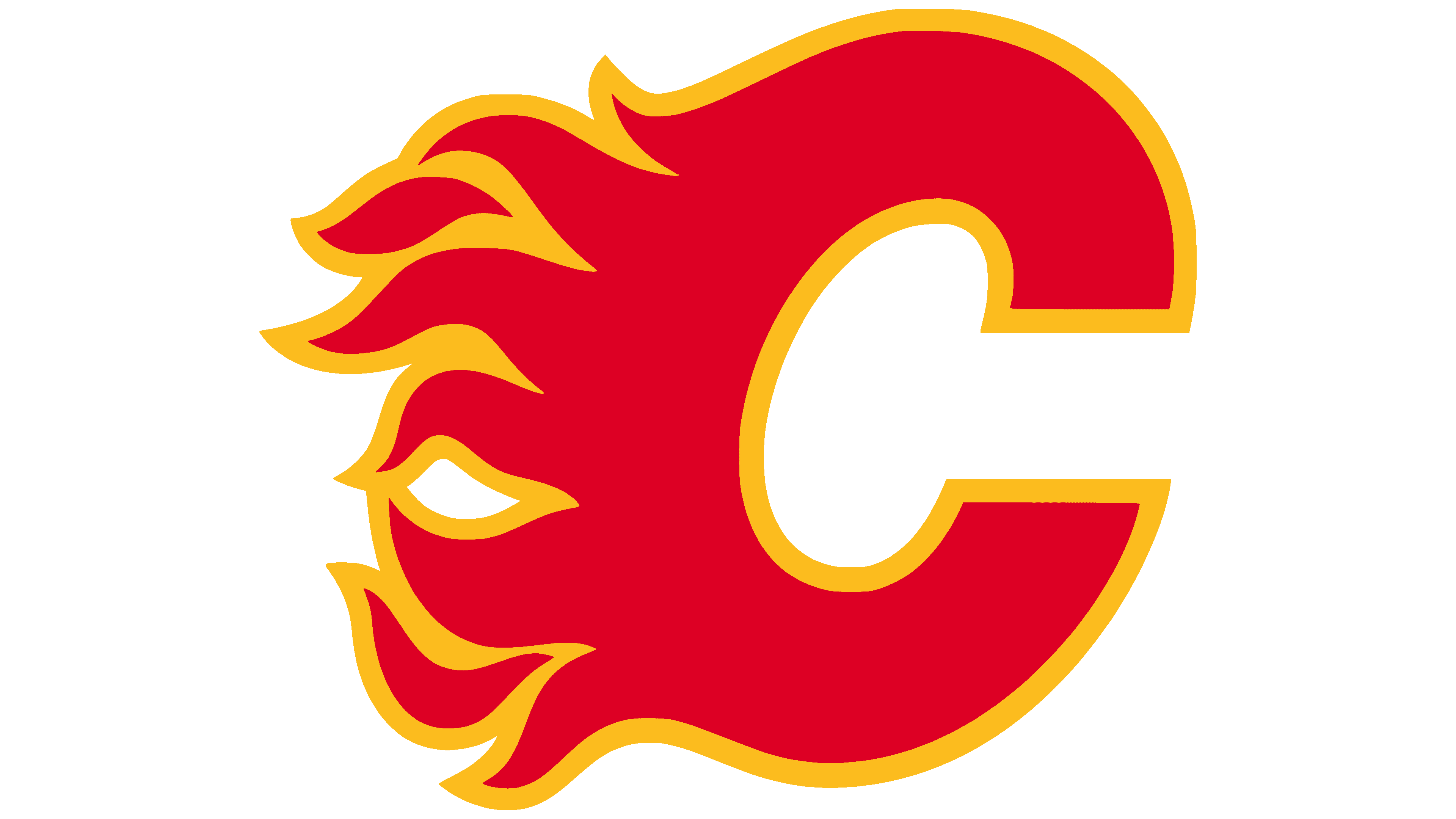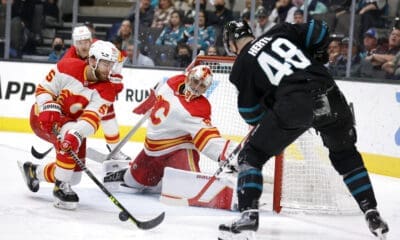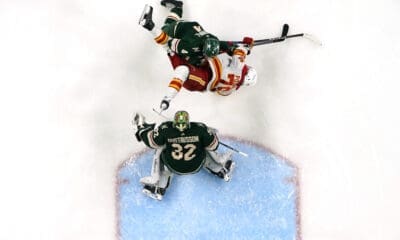Calgary Flames
What if Teemu Selanne became a Flame? Part I: The fun
We play in a historical sandbox, creating an insane, complex universe that exists because one player switched teams.

Hockey seems to be way less fun without Teemu Selanne. His perpetual grin, flashy play, immortality, and Jofa helmet has given NHL fans plenty of positive memories, regardless if he played on their team. Selanne is probably one of the last member of the exciting European 90’s import generation (depending on whenever Jaromir Jagr decides to call it quits, which is probably and hopefully never) that wowed fans across the league and across the world.
Like most of these players, Selanne came into the league with a bang, except it was more of an Earth-shaking explosion. His record 76 goals with the Winnipeg Jets as a rookie is a record that will likely never be touched, and a record no one else has come close to. Mike Bossy is the closest, with 53 goals in 1977-78. The Finnish Flash only played in Winnipeg/Phoenix/Arizona for three and a half years, but still owns franchise records for the nearly 35 year old club: 10th in goals with 147, and 11th in points with 304.
It was almost never meant to be.
After being drafted 10th overall in the 1988 draft, Selanne stayed in Finland due to military and hockey obligations. The Jets had been working frantically to get him over, attempting to sign him at the turn of the decade. Back in those days, the NHL ruled that any European player that had not signed within four years of their draft year became an RFA, sort of like an ELC. The Jets first offered him a three year, $1.2M contract to join the club.
The Flames offered sheeted him to three years at $2.7M.
Wisely, the Jets matched, and the rest is history. But we aren't interested in actual history, it's more fun to play with alternate history. Let's say the Jets didn't match the sheet, and Selanne became property of the Flames. What then happens? How does the 20 year career of the future HOFer unfold? How does the team's history unfold?
On the verge
A few years removed from their first and only Stanley Cup victory, the 1992-93 Flames were still contenders for hockey’s ultimate prize. For a team that still retained key pieces from 1988-89 like Joe Nieuwendyk, Al Macinnis, Theoren Fleury, Gary Suter, Robert Reichel, Gary Roberts, Joel Otto, Mike Vernon, etc, the Flames always seemed to be right there in the mix of things, but could never make them count. A heavy upset against the arch-rival Oilers in 1990 and a disappointing absence from the 1991 playoffs made the team feel that the need to capitalize on a good thing sooner rather than later.
The departure of Doug Gilmour in 1992 for a grab bag of players who never amounted to much (Gary Leeman was the most productive, scoring 23 points in 59 games over two seasons) was a crisis point for the team. The team had to deal with the disadvantages of being good. They didn't have the cash to continue to pay superstars, Gilmour's reason for leaving.
The Flames also had development problems. They lacked quality first round picks, mostly because they didn’t have any, or they didn’t have any in the favourable positions. Poor scouting and decision making also factored in. By 1992, ’87 first rounder Bryan Deasley had sputtered out, and ’88 first rounder Jason Muzzatti hadn’t been as promising as once thought. 1990 first rounder Trevor Kidd (whom the Flames traded up for, letting the New Jersey Devils select Martin Brodeur with Calgary’s original pick, but that’s an article for later) was too far away, as was 1991’s Niklas Sundblad. To take advantage of their aging core, the team needed young blood in the system.
Enter Teemu Selanne. The Jets had begun to feel the financial squeeze which would eventually force the team to relocate to the desert, and were very wary about money. The Flames weren't as penny pinching, and were able to double Winnipeg's offer. Here's where we begin to change history. In this moment, Teemu Selanne doesn't receive an offer from the Jets, or anyone else, and chooses to sign with the Flames. But first, we need to analyze the potential impact of Selanne's arrival to the team.
Teemu and the Jets
When Teemu first hit the league, all expectations were shattered. He was supposed to be good, but not 76-goals-as-a-rookie good. One of the biggest concerns was his supporting cast in Winnipeg, a team that was never really any good. In an era where 16 out of 22 NHL teams made the playoffs, all you had to be was alright to get into the playoffs. Also considering that the San Jose Sharks, Ottawa Senators, and Tampa Bay Lightning had recently entered the fold, three teams were essentially eliminated once the season began. Getting to the playoffs really meant that you had play hockey, breathe air, and maintain a healthy body temperature.
The Winnipeg Jets in the 90s were the very definition of alright. The team often finished low in the Smythe division, and were booted from the playoffs unceremoniously every year. They hadn’t escaped the first round since 1986-87, a record that was broken by the 2011-12 Phoenix Coyotes (the new Jets still haven’t made it out of round one, even as the Thrashers).
Some of this had to do with the 1990 departure of Dale Hawerchuk, the face of the franchise for so long. In his wake, there was not much. The new leader became Phil Housley, who was the only one scoring above a point per game consistently in a time where scoring at that rate was the norm. Housley was a defenceman, no one else was close. Awaiting Teemu would be Thomas Steen, Alexei Zhamnov, Darrin Shannon, and a very young Keith Tkachuk. The rest was mostly deadweight.
Teemu on the Flames
Compare that to the Flames who, while not having a perfect team, still very capable players. They were Smythe division winners three years running until 1990, but had started to slip as the division became stronger. The driving force for the squad was certainly the offence, especially the first line
Flames lines in 1992-93 (statline in brackets GP-G-A-P)
| Gary Roberts (58-38-41-79) | Robert Reichel (80-40-48-88) | Theo Fleury (83-34-66-100) |
| Paul Ranheim (83-21-22-43) | Joe Nieuwendyk (79-38-37-75) | Sergei Makarov (71-18-39-57) |
| Brent Ashton (32-8-11-19) | Joel Otto (75-19-33-52) | Ronnie Stern (70-10-15-25) |
| Craig Berube (77-4-8-12) | Brian Skrudlund (16-2-4-6) | Greg Paslawski (13-4-5-9) |
The first line firepower was certainly among the NHL's best during the time, powering the Flames through the regular season. Then it sort of drops off, especially down the wings. Makarov and Ranheim were fantastic players during the late 80s and first few years of the 90s, but had started to peter out. Nieuwendyk and Otto were stable in the middle, but often had different linemates on different nights. Brent Ashton was acquired from Boston, and Skrudlund and Paslawski were also found in the cellars of other NHL teams.
This is why the Flames wanted Selanne. Makarov, the first Russian player to leave his country without defecting and the only 31 year old to win the Calder Trophy, had his days numbered. 1992-93 would be his last year with the team. The Flames were looking for an inexpensive replacement, and the Jets were lowballing a flashy Finn for his first contract.
So now we have Selanne on the Flames, on a line with future HOFer Joe Nieuwendyk, IIHF Hall of Famer Sergei Makarov, and Paul Ranheim. Makarov was better than Ranheim, and was a left handed shot to boot, so placing him on the left with Selanne on the right makes more sense then having Ranheim on the left with Selanne. There is even the potential he could usurp Theo Fleury's spot on the first line, putting him with even better teammates.
The Transplant
How does that impact Selanne's rookie season now that he's with very capable forwards (with the backing of Gary Suter and Al Macinnis) compared to the Shannon and Zhamnov line he was on in Winnipeg? It's a massive improvement, very massive indeed. Can we quantify that? No, not really. One of the bonuses of advanced stats is that it is much easier to quantify exactly how much of an impact a player makes on his team. Baseball and football analytics folks love to play around with historical data, simulating what it would be like if X played on this team, or what if Y played today. Due to the lack of data collected before the mid 2000s (data which is collected by watching the games), this analytical sandbox is unavailable in hockey, but we'll try to make do.
Selanne clearly boosted the 92-93 Winnipeg Jets. How much? We really can’t say. To speculate, Zhamnov was probably the only player with a CF above or close to 50% other than Selanne (if they were even positive corsi players in the first place). The rest of the team was bad. The 92-93 Jets were the 7th worst teams for shots allowed, and 16th in shots for. Comparatively, the Flames were 18th in shots allowed, and 15th in shots for. Goals also help us: Calgary had a +40 differential, while Winnipeg was a +2, meaning that Winnipeg certainly could not possess the puck to save themselves. Selanne probably dragged them out of the bottom of the league, saving them from either Chris Pronger, Paul Kariya, Viktor Kozlov, or Jason Arnott (maybe saving isn’t exactly the right word in this context).
Although not very scientific, we can guess that the Jets were not a very good possession team, and Selanne's production was mostly the work of himself, and not due to the support of others. Ever since the data has been collected, Selanne has historically been a good corsi player, even in his late career. Making another unscientific leap, we can assume that he would be better in his early career. It may not necessarily be true, but again, we'll make do.
1992-93 and the '93 playoffs in Calgary
Back to quantifying. Selanne's rookie season is by far the best rookie season ever, there's no doubt about that. Assuming that playing on Calgary would've boosted him, it could've gotten even more ridiculous. If 76 goals is ludicrous, then imagine what his totals could be in Calgary. 80 goals? 90 goals? Both absurd, yet imaginable. The greatest rookie season ever would turn into what could be one of the best seasons ever. We would think we stumbled upon the next Wayne Gretzky.
So how does this affect the team overall? We look back to advanced stats. Hockey-reference calculates Selanne’s point share total fo 92/93 at 13.4 (brief read-up and methodology, basically how many standings points the player solely contributed). Assuming that number doesn’t grow from playing on a superior team (even though it likely would), those extra points vault the Flames to the top of the Smythe Division and Campbell Conference with 110 points, which also places them second in the league behind the Pittsburgh Penguins.
At the top of the Smythe, the Flames get an easier playoff opponent in… the Winnipeg Jets. Without Selanne and his 13.4 PS, the Jets sit with 74 points, still good for fourth in the division (Oilers had 60 points hardy-har-har). The real-life Selanne Jets couldn’t get past the powerhouse Vancouver Canucks, falling in six games. The real-life Flames also faltered to the Kings in six, one of the highest scoring series of all time.
Selanne would exact revenge on his cheapskate former team, and the Flames would be off to the second round to face one of the Pacific coast behemoths. This is where it gets hard. Since the Kings and Canucks aren't directly involved in this player swap, we will assume they perform the same, minus a few points in the standings. Should the Canucks win, Calgary faces a tough matchup, but a win nonetheless. The Flames only lost once to the Canucks during 92-93, a snoozer at the end of the season.
The real problem for the 92-93 Flames lies in South California. The Kings struggled in the early parts of the season, but found their true form just in time for the playoffs, just like they do today. They vanquish the Canucks in this simulation as they do in reality, setting them up with the Flames for the division finals. In real life, the Kings and Flames exchanged blowouts, with the Kings taking the final three games.
Does Selanne change anything? It's hard to say. The value he added in 1993 might not be enough to send the Kings packing. As nice as he is, the Kings were just so much better in almost every sense. Their playoff boxscores only stopped looking like video games when they got to the third round. There's really no way to prove this theory, but gut feeling tells me that Selanne may only make the games somewhat closer, but not close enough to win. Kings still win in six or seven.
It’s a boring result, but the most probable. Even if the Flames got by the Kings, they’d face the Maple Leafs who were another tough ask, and one less likely for them to conquer. You might remember the real life series being the infamous no-call series, denying the Leafs a chance at their big rivals, the Canadiens in what would probably be the greatest Stanley Cup final ever (Leafs would still lose, by the way).
Selanne's playoff appearances were also very subdued. One of the least cited reasons for his explosion in 92-93 was the fact that Winnipeg played the worst schedule possible, coming in at -0.23 according to HRef (the Flames were -0.22, so it's not as if Selanne switching schedules would have made a massive impact). When it came time to play the best, Selanne returned to human form, scoring only a point per game, down from his dynamite 1.57 in the regular season. Half of them came in one game
All the magic and wonder simply evaporates when it counts. But hey, they'll have another chance right? Make sure you check out tomorrow's continuation of this series, coming tomorrow.
by xx xx









